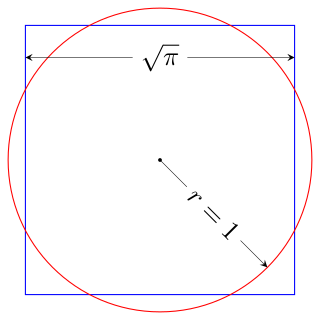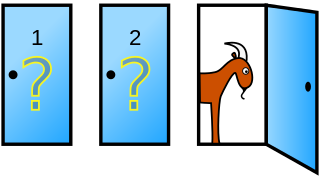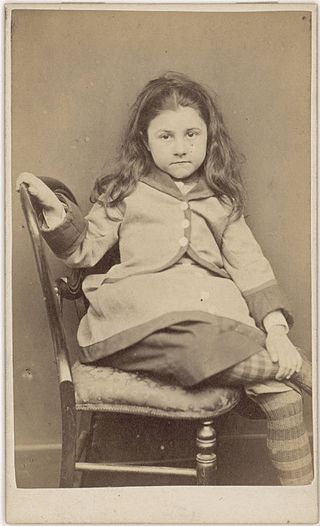Related Research Articles

Through the Looking-Glass, and What Alice Found There is a novel published on 27 December 1871 by Lewis Carroll, a mathematics professor at the University of Oxford, and the sequel to Alice's Adventures in Wonderland (1865). Alice again enters a fantastical world, this time by climbing through a mirror into the world that she can see beyond it. There she finds that, just like a reflection, everything is reversed, including logic.
A logic puzzle is a puzzle deriving from the mathematical field of deduction.

Alice Pleasance Hargreaves was an English woman who, in her childhood, was an acquaintance and photography subject of Lewis Carroll. One of the stories he told her during a boating trip became the children's classic 1865 novel Alice's Adventures in Wonderland. She shared her name with "Alice", the story's heroine, but scholars disagree about the extent to which the character was based upon her.
"What the Tortoise Said to Achilles", written by Lewis Carroll in 1895 for the philosophical journal Mind, is a brief allegorical dialogue on the foundations of logic. The title alludes to one of Zeno's paradoxes of motion, in which Achilles could never overtake the tortoise in a race. In Carroll's dialogue, the tortoise challenges Achilles to use the force of logic to make him accept the conclusion of a simple deductive argument. Ultimately, Achilles fails, because the clever tortoise leads him into an infinite regression.

The Hatter is a fictional character in Lewis Carroll's 1865 book Alice's Adventures in Wonderland and its 1871 sequel Through the Looking-Glass. He is very often referred to as the Mad Hatter, though this term was never used by Carroll. The phrase "mad as a hatter" pre-dates Carroll's works. The Hatter and the March Hare are referred to as "both mad" by the Cheshire Cat, in Alice's Adventures in Wonderland in the sixth chapter titled "Pig and Pepper".

Squaring the circle is a problem in geometry first proposed in Greek mathematics. It is the challenge of constructing a square with the area of a circle by using only a finite number of steps with a compass and straightedge. The difficulty of the problem raised the question of whether specified axioms of Euclidean geometry concerning the existence of lines and circles implied the existence of such a square.

Disentanglement puzzles are a type or group of mechanical puzzle that involves disentangling one piece or set of pieces from another piece or set of pieces. Several subtypes are included under this category, the names of which are sometimes used synonymously for the group: wire puzzles; nail puzzles; ring-and-string puzzles; et al. Although the initial object is disentanglement, the reverse problem of reassembling the puzzle can be as hard as—or even harder than—disentanglement. There are several different kinds of disentanglement puzzles, though a single puzzle may incorporate several of these features.
Knights and Knaves is a type of logic puzzle where some characters can only answer questions truthfully, and others only falsely. The name was coined by Raymond Smullyan in his 1978 work What Is the Name of This Book?
Marilyn vos Savant is an American magazine columnist who has the highest recorded intelligence quotient (IQ) in the Guinness Book of Records, a competitive category the publication has since retired. Since 1986, she has written "Ask Marilyn", a Parade magazine Sunday column wherein she solves puzzles and answers questions on various subjects, and which popularized the Monty Hall problem in 1990.

The wolf, goat and cabbage problem is a river crossing puzzle. It dates back to at least the 9th century, and has entered the folklore of several cultures.
Roger Gilbert Lancelyn Green was a British biographer and children's writer. He was an Oxford academic who formed part of the Inklings literary discussion group along with C. S. Lewis and J. R. R. Tolkien. He had a positive influence on his friend, C.S. Lewis, by encouraging him to publish The Lion, the Witch and the Wardrobe.

Word ladder is a word game invented by Lewis Carroll. A word ladder puzzle begins with two words, and to solve the puzzle one must find a chain of other words to link the two, in which two adjacent words differ by one letter.
The Looking Glass Wars is a series of three novels by Frank Beddor, heavily inspired by Lewis Carroll's 1865 novel Alice's Adventures in Wonderland and its 1871 sequel Through the Looking-Glass. The premise is that the two books written by Lewis Carroll are a distortion of the "true story".

The Monty Hall problem is a brain teaser, in the form of a probability puzzle, loosely based on the American television game show Let's Make a Deal and named after its original host, Monty Hall. The problem was originally posed in a letter by Steve Selvin to the American Statistician in 1975. It became famous as a question from reader Craig F. Whitaker's letter quoted in Marilyn vos Savant's "Ask Marilyn" column in Parade magazine in 1990:
Suppose you're on a game show, and you're given the choice of three doors: Behind one door is a car; behind the others, goats. You pick a door, say No. 1, and the host, who knows what's behind the doors, opens another door, say No. 3, which has a goat. He then says to you, "Do you want to pick door No. 2?" Is it to your advantage to switch your choice?

Sideways Arithmetic From Wayside School is a children's novel by Louis Sachar in the Wayside School series. The book contains mathematical and logic puzzles for the reader to solve, presented as what The New Yorker called "absurdist math problems." The problems are interspersed with characteristically quirky stories about the students at Wayside School.

Charles Lutwidge Dodgson, better known by his pen name Lewis Carroll, was an English author, poet and mathematician. His most notable works are Alice's Adventures in Wonderland (1865) and its sequel Through the Looking-Glass (1871). He was noted for his facility with word play, logic, and fantasy. His poems Jabberwocky (1871) and The Hunting of the Snark (1876) are classified in the genre of literary nonsense.
Mathesis may refer to
The Game of Logic is a book, published in 1886, written by the English mathematician Charles Lutwidge Dodgson (1832–1898), better known under his literary pseudonym Lewis Carroll. In addition to his well-known children's literature, Dodgson/Carroll was an academic mathematician who worked in mathematical logic. The book describes, in an informal and playful style, the use of a board game to represent logical propositions and inferences. Dodgson/Carroll incorporated the game into a longer and more formal introductory logic textbook titled Symbolic Logic, published in 1897. The books are sometimes reprinted in a single volume.

Beatrice Sheward Hatch was an English muse of Charles Lutwidge Dodgson, better known as Lewis Carroll. She was one of a select few children that Dodgson photographed naked, therefore making Hatch the subject of much contemporary study and speculation. Photographs of Hatch still inspire artistic work in contemporary times.

Evelyn Hatch was an English child friend of the adult Charles Lutwidge Dodgson, better known by his pen name of Lewis Carroll. She was the subject of photographs by Dodgson and is often part of the contemporary discussion about Dodgson's relationship with young female children. She also acted as editor for a book of Dodgson's letters after his death called A Selection From The Letters Of Lewis Carroll To His Child-Friends.
References
- Kathleen Blake Play, Games, and Sport: The Literary Works of Lewis Carroll, Cornell University Press 1974. ISBN 0-8014-0834-2
- ↑ Robert D. Sutherland: Language and Lewis Carroll, The Hague, Mouton 1970. ISBN 1-884718-87-6
- ↑ Stuart Dodgson Collingwood The Life and Letters Of Lewis Carroll, Kessinger Publishing 2004. ISBN 1-4179-2625-2
- ↑ Lewis Carroll: The Mathematical Recreations of Lewis Carroll: Pillow Problems and a Tangled Tale, Courier, Dover 1958 (dust jacket)